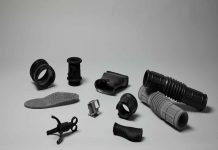Researchers from Monash University and collaborators from CSIRO and Deakin University have printed two proof of concept jet engines.

One is currently on display at the International Air Show in Avalon, Victoria, Australia, while the other is at Microturbo (Safran), a French aerospace company.
The engine design is based on an auxiliary powered gas turbine engine, while the end product is proof that we are on our way to begin development of cheaper, lighter and more fuel-efficient jets.
The Monash team was led by Professor Xinhua Wu, Materials Engineering & Director, Monash Centre for Additive Manufacturing.
“Xinhua and her Monash team have demonstrated their mastery of additive manufacturing in metal. The partnership with Microturbo (Safran) is a success story that was recognised last year when Safran gave the team its Prize ‘Innovation for Product and Technology’ for the excellent work carried out in partnership with Microturbo and the University of Birmingham. Monash and AMAERO are already key partners for our new developments and we are keen to have their help in developing new technologies for our future engines,” said Jean-François Rideau, head of R&T from Microturbo (Safran), in a media release.
The project is supported by the Australian government via the Australian Research Council (ARC), the CRC program, Commercialisation Australia, the Science and Industry Endowment Fund (SIEF); and by Monash University and Safran.
Many believe that the project is sure to create numerous advanced manufacturing opportunities for Australian businesses, with Boeing at the forefront of a line of companies showing great interest in the technology.
“The project is a spectacular proof of concept that’s leading to significant contracts with aerospace companies. It was a challenge for the team and pushed the technology to new heights of success – no one has printed an entire engine commercially yet,“ said Ben Batagol, of Amaero Engineering, the company created by Monash University to make the technology available to Australian industry.
“Australia’s manufacturing industries need access to the latest technologies to stay competitive. This Centre allows them to rapidly prototype metal devices across a wide range of industries. It’s part of a large integrated suite of facilities for research and industry at Monash,” said Professor Ian Smith, Monash University’s Vice Provost for Research and Research Infrastructure.




















